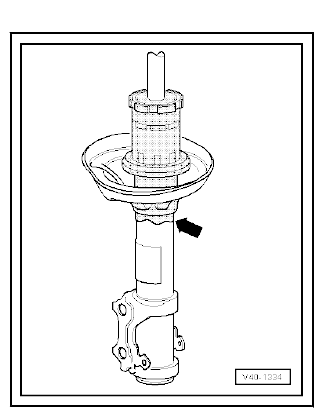Seat Leon >> Leaks at shock absorbers
Shock absorbers are often replaced because of externally visible leakage. Inspections on the test rig and in the vehicle have shown that in the majority of cases this replacement is not justified.
Slight loss of fluid ("sweating") at the piston rod seal is not a reason for replacing a shock absorber. A shock absorber with slight fluid leakage can be accepted as "OK" under the following conditions:
- Fluid seepage (as shown in the shaded part of the illustration) is visible, but the fluid is dull and possibly dried by dust.
- The fluid seepage extends only from the top shock absorber seal (piston rod seal) down to the bottom spring plate -arrow-.

Noises from shock absorbers
Shock absorbers are often replaced because of noises (rumbling, etc.) experienced by the customer. Inspections on the test rig and in the vehicle have shown that in approx. 70 % of these cases there is no case for complaint. The replacement was not justified.
In the case of complaints regarding rumbling or knocking noises please proceed as follows.
- Carry out a road test with the customer - if possible on a dry, uneven road - to establish when, where and how the noises occur.
Note These noises are only very rarely caused by the shock absorbers.
Checking shock absorbers when removed
Defective shock absorbers can be identified by loud rumbling noises when driving, caused by wheel hopping, especially on bad roads. Heavy fluid leakage is an additional visual indication.
Note Shock absorbers are maintenance-free; shock absorber fluid cannot be topped up.
After removal, a shock absorber can be checked by hand as follows:
- Compress shock absorber by hand.
- The piston rod should move smoothly over the entire stroke with uniform resistance and without jolts.
- Release the piston rod.
- If the shock absorber has sufficient gas pressure the piston rod will return by itself to its original position.
Note
- If this is not the case, the shock absorber does not necessarily need to be renewed. Provided there has been no major loss of fluid, it will still be as effective as a conventional shock absorber.
- Even without gas pressure, the shock absorber will provide full
damping effect as long as there has been no major loss of fluid.
However, it may produce more noise.
 Steering box
Steering box
To achieve the desired results when performing repairs on the
steering box it is important to work with the greatest possible care
and cleanliness, and to use proper tools in good condition. Always
...
See also:
Position in engine compartment: side box
Fuses
Some of the electrical items listed in the table are only fitted on certain
models or are optional extras.
Please note that the above list, while correct at the time of printing, is
sub ...

